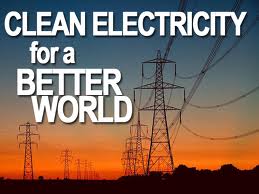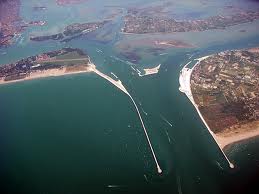Producing electricity is often a dirty and polluting affair. Here in the US most is still produced by burning coal, rather like in the 19th century. Nuclear power production is seen by some as an answer as it doesn’t throw a tone of gasses and toxins into the atmosphere and can produce an enormous amount of power in comparison to the fuel it uses. But nuclear power brings its own sets of problems, you only have to look at recent events in Japan or take a trip to Ukraine to see that. And parts of the North Sea round the British Isles are contaminated from leaks from an infamous UK nuclear power station that shall remain nameless (although like New York it too was so good they named it twice) and the unforeseeable problems involved in storing radioactive waste for tens of thousands of years to name but a few rather thorny issues.
However some people that define themselves as fighting for a cleaner environmental electricity production policy, do argue that nuclear power is a move in the right direction, that alternative forms could never provide enough power to feed the planet and the very fact that nuclear power production does not create tons of carbon means it is advantageous in fighting the possible problems of global warming. There are undoubtedly advantages and disadvantages to this form of power production, but political and financial interests are also important factors to bear in mind.

There are several other ways of producing cleaner electricity though as we know, but they too have their problems. Building a dam to use the water to drive turbines can have devastating effects on the surrounding areas. Look at the Yangtze Dam project in China and the effect of this engineering project on the people and animals that used to inhabit the newly flooded areas.
Wind farms also seem a good solution but some people say they are ugly and here in Cape Cod in the US there is a large protest movement growing out of claims by people that live near wind turbines who claim health problems, stress and migraines due to the flickering effect of the blades turning in the sun.
Solar panels are always sold as a good option, but they are expensive to manufacture because processed silicon is costly due to its high demand. There are also the problems of how to dispose of the panel when it is no longer efficient and the nature of the silicon purification process.
In Italy farmers have taken government subsidies and covered their land with solar panels in a bid to improve profits. In some cases the panels form a sort of protection for the crops while they produce electricity, but in a lot of cases the agricultural land is just lost to a sea of silicon, causing people to complain both about the aesthetics and the land use issue. Government green incentives mean that there is no need to ask for planning permission so these ‘silicon farms’ as they are known are cropping up in some rather inopportune places (sorry, couldn’t resist the pun) and are in massive expansion as this article demonstrates.
But fortunately as we would hope in a blog like this there have been some really interesting developments recently in non silicon based solar energy production that we can look at.

Harnessing the sun
A couple of years ago researchers in Italy unveiled something called the Dye Solar Cell (DSC). It doesn’t use silicon to produce electricity but guess what? It uses vegetable dye from egg plant (aubergines). Well not being a scientist myself I thought, ‘yes, plants do photosynthesis don’t they, why didn’t I think of that?’, and I wasn’t far wrong.
The cells don’t have the same productive power so the area needs to be bigger to produce the same amount of power but they are incomparably cheaper and greener. Ideal for use for example on large low buildings such as barns or industrial units that can have the entire roof covered in vegetable cells and produce the electricity the occupants require for free. Good news.
But what if you haven’t got a huge roof? Well an Austrian company called Bleiner AG has developed a type of paint called Photon Inside that has the same capability. It has to be applied in a few coats and cost more than standard paint but a 50 square metre wall generates 3 Kw of electricity. It was developed for use on sailing boats so that they could operate a radio and radar while out at sea. Sorry but the only articles I can find online are in Italian.
Konarka is an interesting American company who have developed a power generating plastic. It can be made very thin and comes in a roll that you just cut to size, stick on your Venetian blinds or any other surface that takes a lot of sun and away you go. They also sell Power Fibre, as you would imagine it is a thread that you can weave, so you can make textiles that produce energy and can be made into clothes. I like this idea, you could buy a computer case that charges the computer using sunlight as you walk to work.
At the Massachusetts Institute of Technology (MIT) they have recently unveiled their ability to print solar panels on to paper. A great breakthrough as it makes the technology easy to transport and place in position but also cheap and hardwearing (you can laminate it). Research at the University of Verona in Italy goes one step further, they are developing completely transparent thin sheets of solar panels that you can attach to the window and look through.
These final applications described above really take solar electric production to a higher level, as practically any surface can be used to produce electricity. The breakthrough here is in the technology required to transport the current more than its production, as attaching the diodes has long been the most difficult part of thin surface electricity production as they tend to come off with any movement in the surface.
Using the sea is also an option. Off the UK there is the giant Sea Snake trial taking place as well as the Oyster wave generator installation, and in the US buoys have been developed that generate electricity from their constant up and down motion, easy to place and a help rather than a hindrance to shipping.
As Christopher pointed out in a recent post, global warming is a real and serious problem and electricity production could be a major element in pollutant gas production, but as I hope to have shown above there are many interesting developments if we allow ourselves a slightly different point of view on electricity management.
A less centralized way of thinking and we could produce a lot of the electricity we need in situ, using our own buildings as power plants.
I have written more extensively on this problem on the Bassetti Foundation website and there are also various related articles about renewable energy sources and the problems involved in their use.
Next week I will have a look at possible engineering solutions for the problematic issue of global warming.




